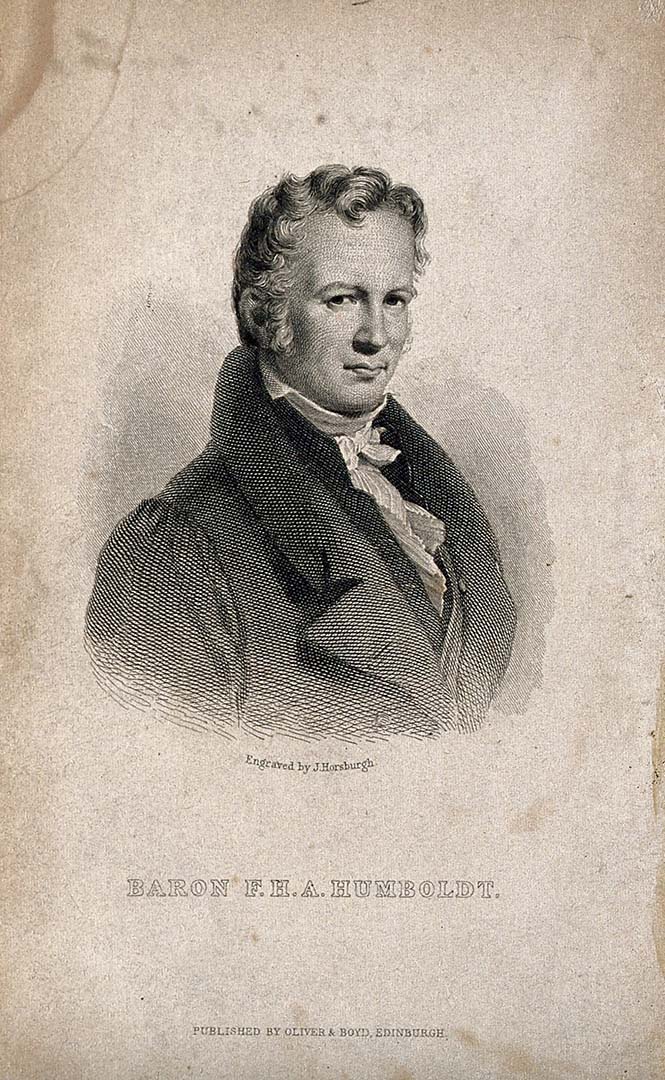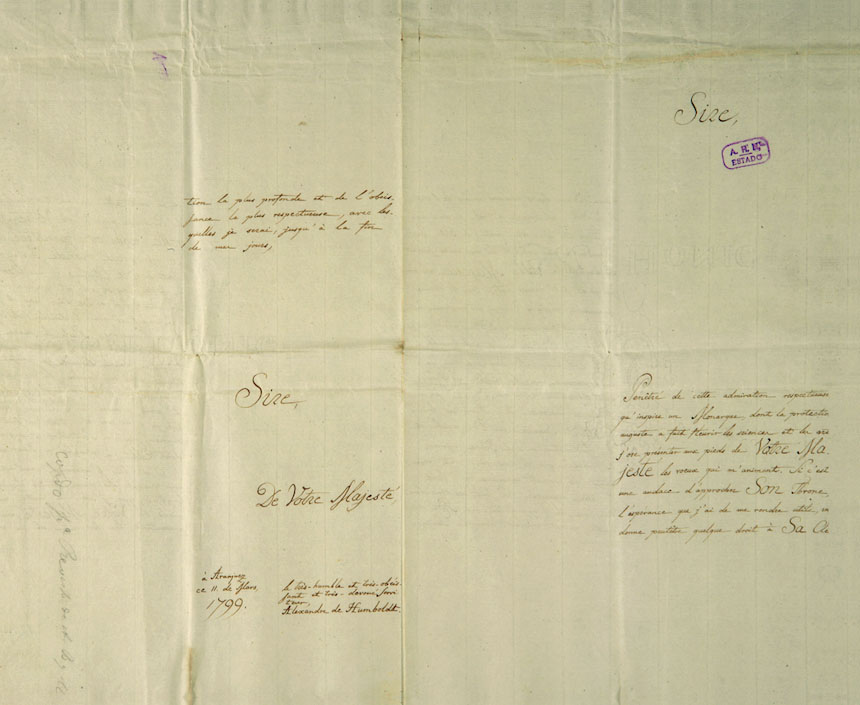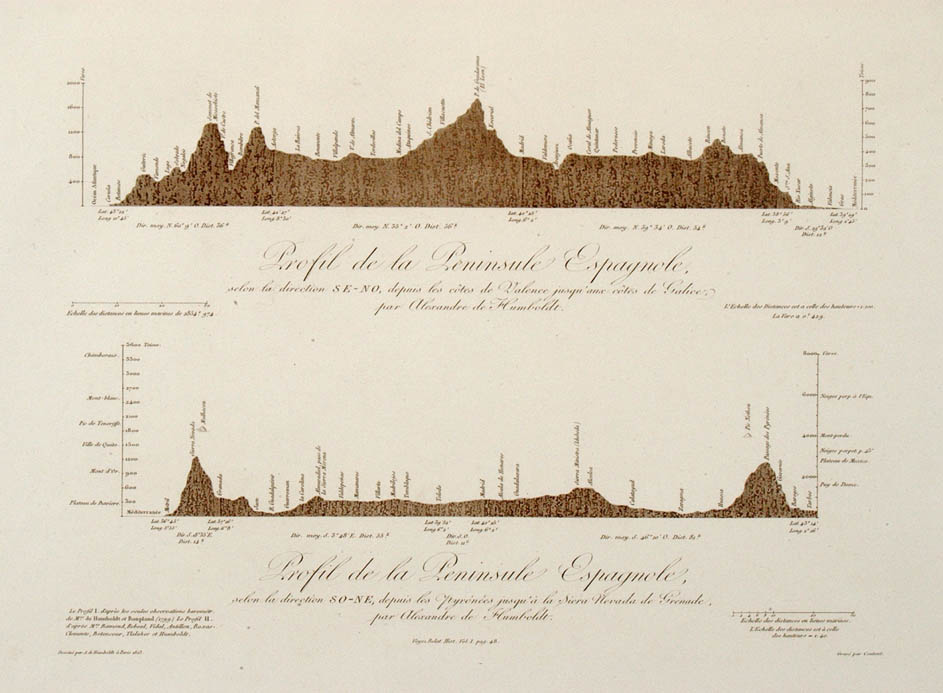
Alexander von Humboldt in Spain
One of the most unknown aspects of Alexander von Humboldt’s journey is his passing through Spain, particularly his scientific work, his contacts and his preparations for exploring the New World, together with French Botanist and Doctor Aimé Bonpland.
The main reason why he chose to travel to Spain was due to the failure of his previous plans for traveling to Africa. After deciding to make an expedition to the Spanish territories in America, he needed King Charles IV’s permission. Humboldt’s diplomatic skills and connections with influential people in politics and science enabled him to obtain the necessary authorization to carry out his project.
Humboldt arrived in Spain via Catalonia in December 1798, alongside Aimé Bonpland. Shortly afterwards they began their route through Valencia and La Mancha to Madrid, where they arrived in early February of 1799. He stayed at the house of David Tribolet-Hardy, the Prussian chargé d’affaires, on Cantarranas Street in the capital, although we know that he spent most of his time in Madrid at the Fontana de Oro, an inn for gentlemen. During those first days, Humboldt began his visits to Royal Botanical Garden of Madrid, where he could study American plants and meet enlightened men.
Friedrich Heinrich Alexander von Humboldt.
Source: Wellcome Collection. Attribution 4.0 International (CC BY 4.0)
Once settled in Madrid, Tribolet-Hardy put him in touch with the key figure who could obtain a project’s approval. This was Baron Phillip de Forell, Saxony’s ambassador to Madrid, a distinguished mineralogist and a personal friend of Minister Mariano Luis de Urquijo. The intervention of the Saxon ambassador – supported by Dutch Ambassador Johan Valckenaer – was providential for Humboldt, who quickly achieved political protection and established the scientific links required for preparing the trip to America. Humboldt also visited the Royal Cabinet of Natural History, a scientific institution with which the Saxon ambassador collaborated with his mineralogical collections and where he had even managed to position two Germans as collectors, Juan Guillermo and Enrique Thalacker.
Simultaneously, Humboldt established scientific relations with chemists Louis Proust and Domingo García Fernández, who along with Botanist Cavanilles and Herrgen were about to publish the first Spanish scientific journal, the Annals of Natural History. He also became acquainted with Juan Bautista Muñoz, the distinguished historian who organized the General Archive of the Indies back then and was preparing his “History of the New World”; with José Chaix, a prominent astronomer who had worked with Delambre and Méchain in the measurement of the meridian arc in Spain and who was one of Humboldt’s main collaborators; and also with the group of enlightened sailors who were mostly connected with the Hydrographic Deposit of Madrid.
Alexander von Humboldt’s proposal. Presented to Carlos IV, King of Spain, at Aranjuez the 11 march 1799.
Source: Archivo Histórico Nacional, Estado, Madrid.
Regarding his hearing at the Spanish Court, he recalls his own testimony in “Journey to the Equatorial Regions of the New Continent”, where he specifies that he was received by King Charles IV in March 1799, with the direct support of Minister Mariano Luis de Urquijo. A few days later, Humboldt’s American journey and passport were approved, which opened all the doors to the Spanish territories in America.
They continued their voyage in the middle of May through El Escorial, the lands of Castile and Lugo as far as La Coruña. On June 5th they embarked on the frigate Pizarro to America, stopping at the Canary Islands.
During the trip, he took the opportunity to conduct extensive scientific research – mostly geographical, geological and climatological – on the regions of Spain. Thus the young scholar tested his new measuring instruments – sextant, chronometer, barometer and thermometer – that he had brought from Paris and used them to determine the altitude above sea level, as well as the astronomical location of significant geographical points. He also studied the geological formations of the Castilian plateau and went up Montserrat, while Bonpland was in charge of the flora. Humboldt became the discoverer of the Iberian Peninsula meseta (plateau). This was a relatively unknown fact that he published in the German magazine Hertha in 1825, in an article entitled “On the configuration and climate of the plateau of the Peninsula”.
The trip through Spain was the preparatory trip for the American project since they conducted research that would be used to begin their work in America as well. If Humboldt appeared as a new Columbus in America – the rediscoverer of the American continent – his exploration of the Peninsula was much more limited, since it contained data and observations of great value, which he would later expand in the Canary Islands. However, he did not provide the global, holistic vision that would appear in his American work.
Iberian Peninsula Profile.
Source: Humboldt, Alexander von. Atlas géographique et physique des régions équinoxiales du Nouveau Continent, Paris, Librairie de Gide, 1814-1838.
Humboldt made some considerations on the peninsula’s climate in his article in Hertha, highlighting the climatic modification of the inland region as a consequence of the plateau’s elevation, which was associated with the presence of an authentic continental climate, contrasting with the mild coastal climate. In short, it is a rather brief text, unlike the beautiful descriptions he made of the Canary Islands, where, in addition to his insights on volcanism or plant geography, he left us several fine pages on the aboriginal population and Canarian society at the end of the century.
To sum up, it can be said that Alexander von Humboldt’s journey through Spain was the first time that a scientist measured the third coordinate -that of altitude- consciously and consistently in a country that was almost unknown. Using modern barometric height measurement methods, he gained a clear picture of the formation of the Earth, not in a speculative manner as was done at the time, but in a purely empirical and scientific manner. The measurement results, together with the valuable location determinations, were set into a profile – a major innovation – which has become an indispensable means of representation in science.
Miguel Ángel Puig-Samper is a biologist and research professor at the Institute of History of the Spanish National Research Council (CSIC). Corresponding member of the Royal Academy of History of Spain, the Colombian Academy of History and the Mexican Academy of Sciences. Former director of the CSIC Publishing House (2005-2013), he also has been director of the CSIC Arbor journal, editor-in-chief of the Annals of the Botanical Garden and is currently director of Asclepio magazine. He is a researcher for the project Connected Worlds: the Caribbean, Origin of Modern World (H2020-MSCA-RISE-2018). Editor and author of approximately 50 books and over a hundred articles and book chapters, including “Sentir y medir. Alexander von Humboldt en España”, Madrid, 2007. Curator of the exhibition “A Journey of the Spirit: Alexander von Humboldt in Spain” at the Cervantes Institute.




I already knew it, but what always amazes me, in a Great Scientist like Humboldt, is that he (wrongly) “ignored” Portugal.
Some of the Most Misterious, Historical (Knowledge) Sites of The Hiberian Peninsula, are in Portugal.
That’s my thought and conviction that, not coming to Portugal, he missed a great opportunity to Discover, perhaps, The Reason why his high spirit of Researcher, brought him to our so Ancestral and Beloved Peninsula.